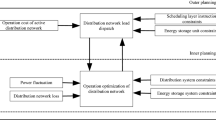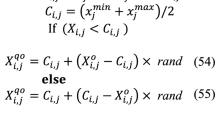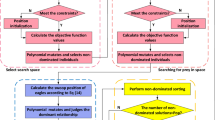Abstract
Aiming at industrial parks and business parks equipped with photovoltaic (PV) power plants and vanadium redox battery energy storage devices, this work studies the collaborative scheduling optimisation problem of real-time response of two-area active distribution system to the random peak shaving demand of large power grids. Firstly, considering the randomness of source and load, the stochastic dynamic changes of PV output, various load demands and the grid peak shaving demand are described as Gauss-Markov processes. Secondly, the hierarchical dynamic control mode is used to transform the collaborative dynamic scheduling problem of two-area active distribution system into a two-layer scheduling optimisation model. The upper layer considers the total cost of operation as the optimal goal and resolves problems related to the task assignment of peak shaving demand for active distribution systems in each area. Meanwhile, the lower-layer areas are optimised to complete the peak shaving task assigned by the upper layer and realise the economic operation of the active distribution system in each area. This study proposes a corresponding model-independent double-layer Q learning algorithm to optimise the hierarchical scheduling strategy. A simulation is conducted to verify the effectiveness of this algorithm. These results indicate that the hierarchical scheduling optimisation mechanism and double-layer Q learning algorithm can effectively solve the collaborative scheduling problem of two-area active distribution systems considering the peak shaving demand of the power grid.
























Similar content being viewed by others
References
Breipohl AM, Lee FN, Zhai D et al (1992) A Gauss-Markov load model for application in risk evaluation and production simulation. IEEE Trans Power Syst 7(4):1493–1499
D’Adamo C, Jupe S, Abbey C (2009) Global survey on planning and operation of active distribution networks: update of CIGRE C6.11 working group activities. In: CIRED 2009 (20th international conference on electricity distribution).Prague, CZ:IET Services Ltd, pp 1–4
Davatgaran V, Mortazavi SS, Saniei M, Khalifeh M (2013) Different strategies of interruptible load contracts implemented in reliability constrained unit commitment. In: 2013 21st Iranian conference on electrical engineering (ICEE), Mashhad, pp 1–6. https://doi.org/10.1109/IranianCEE.2013.6599884
Ebrahimi R, Ehsan M, Nouri H (2013) A profit-centric strategy for distributed generation planning considering time varying voltage dependent load demand. International Journal of Electrical Power and Energy Systems 44(1):168–178
Guo N (2009) Research on Mobile Robot Path Planning Technology Based on Simulated Annealing-Q Learning, Nanjing University of Science and Technology
Hong YY, Lian RC (2012) Optimal sizing of hybrid wind/PV/diesel generation in a stand-alone power system using markov-based genetic algorithm. IEEE Trans Power Delivery 27(2):640–647
Karthikeyan N, Pillai JR, Bak-Jensen B, Simpson-Porco JW (2019) Predictive control of flexible resources for demand response in active distribution networks. IEEE Trans Power Syst 34(4):2957–2969. https://doi.org/10.1109/TPWRS.2019.2898425
Li YZ, Niu JC (2009) Forecast of power generation for Grid-Connected photovoltaic system based on markov chain. Power and energy engineering conference, 2009. APPEEC 2009. Asia-pacific, IEEE, pp 1729–1733
Li YJ, Tang H, LV K, Guo XR, Xu D (2018) Modeling and learning-based optimization of the energy dispatch for a combined cooling, heat and power microgrid system with uncertain sources and loads. Control Theory & Applications 35 (01):56–64
Liu D, Chen YH, Huang YH, You Y, Yu WP (2014) Hierarchical energy management and coordination control of active distribution network. Proceedings of the CSEE 34(31):5500–5506
Lund CW (2002) Management of fluctuations in wind power and CHP comparing two possible Danish strategies. Energy 27(5):471–483
Millar RJ, Saarijarvi E, Lehtonen M et al (2014) Impact of node specific load growth and microgrids on distribution network. CIGRE
Qiu Y, Li X, Wei D, Yu L (2017) Flexible charge-discharge control of vanadium redox battery. Energy Storage Science and Technology 6 (01):78–84
Sun J, Mori Y, Nakade K. (2018) A study of total optimisation model for supply balance in electric power market network, Asian. J Management Sci Appl 3(4):340–352
Sun YT, Song YQ (2018) Peak load regulation trading mode for trans-provincial aid based on evaluation of system regulation capability. Power System Protection and Control 46(04):86–91
Tang H, Wang C, Masayuki M, Liu B (2015) Hierarchical coordinated control of a multi-procedure CSPS system by learning optimisation methods. Int J Prod Res 53(7-8):2055–2072
Ubermasser S, Leber T, Stifter M et al (2014) Maximizing local renewable energy consumption by shifting flexible electrical loads in time and space. CIGRE
Wang LL (2015) Multi-objective planning for distribution network with distributed generation considering demand response. Dissertation, Chongqing University
Wang HX, Yan HS, Wang Z (2014) Adaptive assembly scheduling of aero-engine based on double-layer Q-learning in knowledgeable manufacturing. Comput Integr Manuf Syst 20(12):3000–3010
Xu XL, Song YQ, Yao LZ, Yan Z (2017) Power-output allocation for peak regulation of regional grid with high penetration of renewable energy resources. Electric Power Automation Equipment 37(08):43–51
Yu J, Sun HB, Shen XW (2017) Optimal operating strategy of integrated power system with wind farm, CHP unit and heat storage device. Electric Power Automation Equipment 37(06):139–145
Zhai D, Breipohl AM, Lee FN et al (1994) The effect of load uncertainty on unit commitment risk. IEEE Trans Power Syst 9(1):510–517
Zhang YM, Jia QS (2014) RFID Based scheduling of storage batteries of BIPV systems and optimization their charging and discharging in a microgrid environment. J Syst Sci Math Sci 34(12):1508–1516
Zhang Y, Wu C (2010) Optimal placement of DG unit in distribution system. Power System Protection and Control 38(11):33–37 + 43
Zhao J, Wang C, Zhao B et al (2014) A review of active management for distribution networks:current status and future development trends. Electric Power Components and Systems 42(3/4):280–293
Acknowledgements
This work was supported by State Grid Corporation of China Project ”Intelligent Scheduling Technology based on Deep Learning in Flexible Enviroment (SGTYHT/19-JS-215)”
Author information
Authors and Affiliations
Corresponding author
Additional information
Publisher’s note
Springer Nature remains neutral with regard to jurisdictional claims in published maps and institutional affiliations.
This article belongs to the Topical Collection: Topical Collection on Smart Cities
Guest Editors: (Samuel) Qing-Shan Jia, Mariagrazia Dotoli, and Qian-chuan Zhao
Rights and permissions
About this article
Cite this article
Tang, H., Liu, C., Cao, Y. et al. Hierarchical scheduling learning optimisation of two-area active distribution system considering peak shaving demand of power grid. Discrete Event Dyn Syst 31, 439–468 (2021). https://doi.org/10.1007/s10626-020-00335-9
Received:
Accepted:
Published:
Issue Date:
DOI: https://doi.org/10.1007/s10626-020-00335-9




